Newark Academy
91 South Orange Avenue Livingston, NJ
Phone: 973.992.7000
Fax: 973.992.8962
www.newarka.edu
E-mail: outreach@newarka.edu
Return service requested

Newark Academy
91 South Orange Avenue Livingston, NJ
Phone: 973.992.7000
Fax: 973.992.8962
www.newarka.edu
E-mail: outreach@newarka.edu
Return service requested

Whether learning to prepare fine pastries or following in the footsteps of a surgeon, Senior Projects expand the NA experience.
Whether learning to prepare fine pastries or following in the footsteps of a surgeon, Projects expand the NA experience.







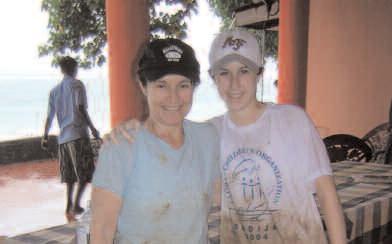
Elizabeth Penney Riegelman Head of School
Fred McGaughan Director of Institutional Advancement
EDITOR
Debra W. Marr Director of Communications
C ONTRIBUTING WRITERS
Blackwood ParlinNancy McGaughan
Alexandra MahoneyKeri Nowicki
Ed ManiganJohn Olesky ’74 Tracy Robinton ’05
BOARD OF TRUSTEES
William D. Green ’69 Chairman
David G. Hardin ’73Gerald Lustig Vice ChairmanVice Chairman
Julianne RoseErnest W. Loesser SecretaryTreasurer
Lynda Baccoli Jonathan D Olesky ’74
Anne EssnerAnita Porto
Randy FrankelRichard Redmond ’77
David N.W. GrantE. Penney Riegelman
Nancy Baird Harwood ’73John B. Rubinstein ’64
Noreen HassanDr. Andrew Senchak
Wayne D. Kent ’85Robert Silver
Joseph McGrath ’81Jeff Silverman ’84 Carrie Somberg
Emeriti
Louis V Aronson II ’4 John L. McGraw ’49
Paul Busse ’38Robert S. Puder ’38
William D. Hardin ’44William T. Wachenfeld ’44
AL UMNI B OARD OF GOVERNORS
Leo M. Gordon ’69 President
Need name of VP Vice President
Scott N. Newman ’73 Secretary
Lance Aronson ’74Jane Florin Langendorff ’80
Betsy Dollinger Bernstein ’86Andrew J. Mulvihill ’81
Harris CohenRichard Rapp ’71
Nita Dang ’90Jed Rosenthal ’93
Leslie Abney Ford ’74Amanda H. Rubinstein ’97
Kim S. Hirsh ’80Van Stevens ’65
Ian Josloff ’90Richard Szuch ’80
Pamela Helfant Vichengrad ’94
Emeriti
J Richard Beltram ’41William C.H. Stroh III ’48
Richard M. Watson ’50
GRAPHIC DESIGN
Abbie Moore Design
PHOTOGRAPHY
Robyn CraigJerry Millevoi
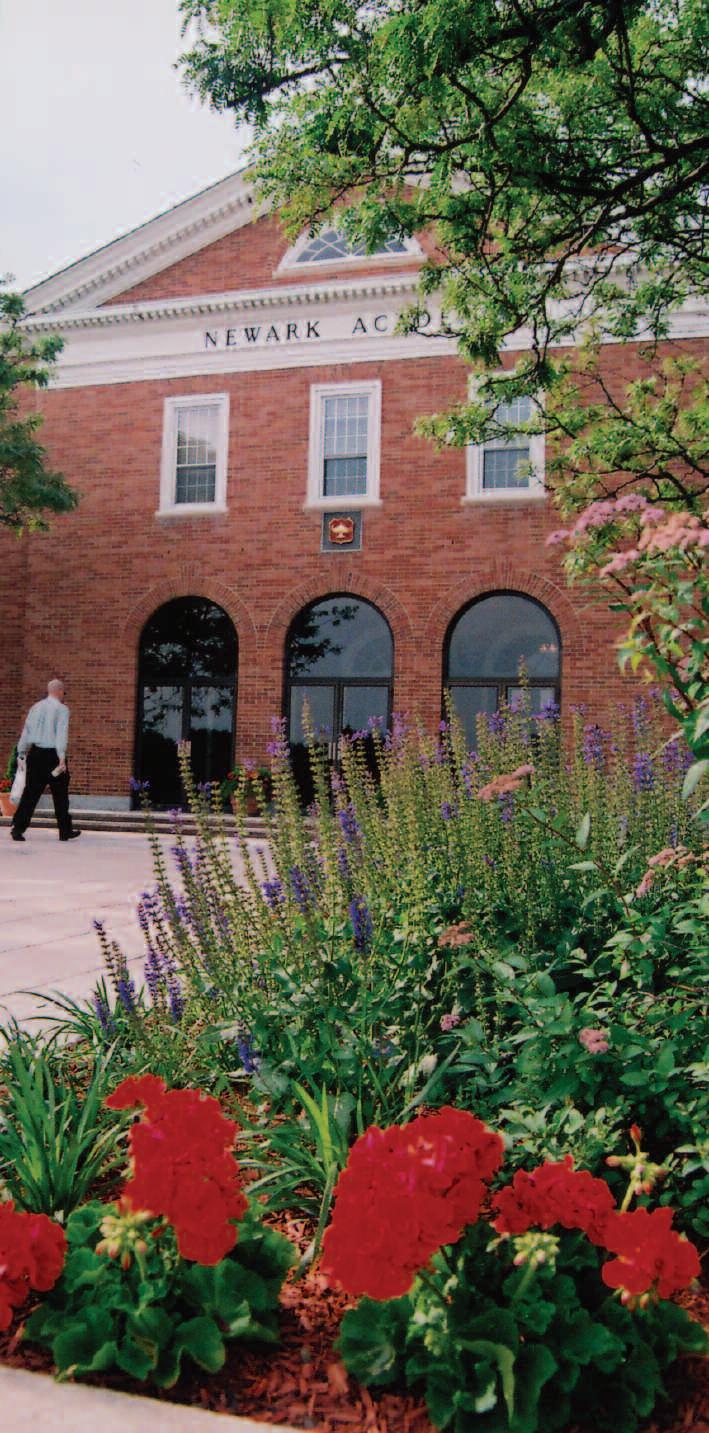
Each September for the past 15 years, Fred McGaughan, our director of admission, has assured the faculty that he has assembled the best student body ever. So far, he has been right every year. This summer, Fred has changed hats and offices to take on the challenge of managing the Academy’s advancement, alumni and marketing endeavors. He will bring NA’s characteristic combination of intelligence, talent and spirit to his new role. Here’s a taste of his perspective.
Elizabeth Penney RiegelmanAs most of you know, Newark Academy is a place where hard work meets high hilarity –I’ve never worked in a place that, at its core, believes so much that life is a joyous experience. Some great examples of this come from Spirit Week cheers that resound in morning meetings and pep rallies each October. My favorite cheer involves the cheerleaders exhorting various constituencies to shout out, “We’re Ready!” This cheer dates back to the early ’90s when Mary Burg was revitalizing the cheerleading squad. The squad will ask, say, the junior class, the question, “Juniors, Juniors are you ready?” to which the juniors reply with gusto, “We’re ready!” But the best, most typically NA-like conclusion to each segment of this cheer is the funky dance the cheerleaders break into as everyone in the building sings and dances to the words “Boogie, boogie, boogie, ah boogie down!”

Even Blackie Parlin (or should I say especially Blackie Parlin) gets into the spirit of things. One year he spoke at morning meeting and taught the community what he considered to be an enthusiastic yet fittingly erudite cheer that went like this: “Retard them. Retard them. Make them relinquish the ball!” And leave it to the kids to come up with their own cheers. Our rival may be wearing the color blue while NA sports the red, and in keeping with spirit, sportsmanship, and of course good humor, the NA students holler, “Red is very good; blue is not so good!”
I share this with you, because as director of institutional advancement, I suppose I’m a cheerleader, and right now NA faces one of the biggest challenges in the school’s history: We simply must, now, ensure the long-term health of this great school by building the endowment. Please call us, write us, and visit our school or our website to show your support for this wonderful place. Are you ready? Then let’s “Boogie Down!”
signature needed
Fred McGaughan
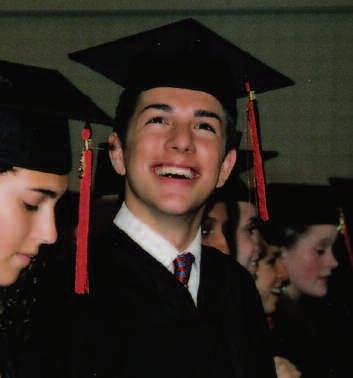
12, 2005 TIMEDOESSOMEFUNNYTHINGSTOTHEMIND IN ANOTHERFOURYEARSWEWILLHAVE FORGOTTEN THE THINGSWEVOWEDWE’D NEVER FORGET, AND WE’LL BE LEFT WITH OUR 16 LINES OF INITIALS AND JIBBERISH, PUZZLING OVER THEM LIKE HIEROGLYPHICS, LIKE THE KEYTOTHE HEART OF SOME LONG-BURIED CIVILIZATION

And so it has become of primary importance for me to takethis time to make some accounting of the time I’ve spent here, while I am still, to some degree, able to do so. I understand a little bit about the cutting room floor of human consciousness, and I know that it is only a matter of time before my subconscious has managed to reduce the incredibly vivid range of experiences I’ve had here into a single odious montage, most likely soundtracked to Blink182. I give most of you around two years before you’ve convinced yourselves that your lives here really did revolve around the twin axes of Homecoming and Prom, and you begin to have more and more trouble distinguishing your bona fide memories of high school from the plotlines on Saved By the Bell I am not saying that it is wrong for us to be nostalgic, but it is important that we know exactly where we stand. They love to tell you that the winners write the history books, but what they forget to mention is that the winners’ children never once bother to read them.
‘‘Time does funny things to the mind.
’’
And so, Class of 2005, I ask you the only question that I think can possibly matter at a time like this: what were you doing all this time? How, honestly, did you spend your four years as a high school student? Your 1,461 days. Your 35,064 hours. Can you account for all that time with dances and elections and tests and homework and parties and dates and all of the other garbage they told us that high school was all about? I didn’t think so. So where is the rest of it? Where is all of the time that seems to have already fallen into the crevices between neurons? I am going to give you my answer today, but I sincerely hope that you will, at some point, take the time to arrive at your own conclusions.
For my part, I spent the overwhelming majority of my high school years – of my entire childhood, in fact – in one of the following two conditions: (1) I was bored (2) I was waiting for something to happen.
So let’s take a moment to admire boredom for a littlebit. Only in a bizarre place like modern America would I feel the need to defend my favorite state of mind. Because only a nation as strange as ours would manage to arrive at the very odd idea that that which is boring is automatically not worthwhile. In this culture of instant gratification we have a tendency to plot our lives like action movies: we rush around all day doing “interesting” things (usually involving explosions and vast quantities of hair gel) and then arrive at a whole that is completely devoid of value. Which is why I believe that it is boredom that creates the value in our lives. Think about the friends you have made here – how would you characterize the ones that are the very closest to you? They are the people with whom you spend time almost by default, when there’s nothing else going on. They are the ones into whose houses you walk uninvited. In short: they are the ones you enjoy being bored around the most. I’d like to tell one story that I think may illustrate my point. It takes place, as it happens, during a speech – freshman year convocation, in fact.
I had the good fortune to be sitting next to a dear friend of mine who is now sitting among you. Alas, we were not then the fully developed paragons of wisdom and virtue that stand before you today Around the 25th minute of our distinguished speaker’s speech, we looked at each other. We were bored. With the skill born of long practice, we took stock of the resources at our disposal. They were slim. We had the change in our pockets and the light brown programs they gave us at the door. Wordlessly, my friend took his program and deftly folded it into a kind of origami bowl. Wordlessly, I took the bowl away from him. I then tore my program into a bunch of triangles of light brown oak-tag and put them all into his bowl. I took one and put it into my mouth, and then offered the bowl back to him. He took one, bit into it, and grinned at me. By the conclusion of convocation,

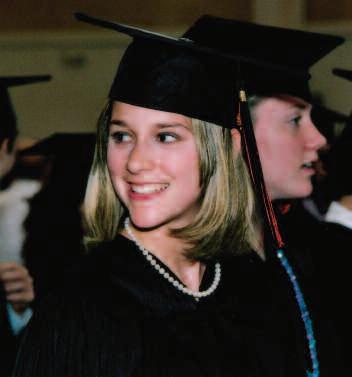
we had eaten every one of our improvised corn chips. I share this anecdote with all of you as a way of telling you that these are the moments to treasure in high school – these are the things that are lasting, and valuable, and permanent: not the things that we did because we had to, but the things we did when we had nothing else to do. I would be remiss if I failed to address the academic portion of our stay at the Academy, but surprisingly it is here that I do not exactly know what to say. It is as if I have been called upon to speak about my hair color, or my height. The education I have received here has become such an integral part of my sense of myself as a human being that I can no more imagine being without than I could imagine being deaf or blind. I can, however, at least speak for all of us when I thank ourteachers for making us the people we are today. We walked into high school bored, yes, and waiting for something to happen to us. We walkout men and women with a sense of purpose and a sense of our place in the world. You are the ones responsible for providing us with that. Our professors may give us jobs and careers, but I don’t think any of us will ever again have our minds so thoroughly shaped, molded, and recast – at least until we get married.
than with doing anything interesting. I guess not everyone is as adept at being bored as all of us. But just in case you’ve forgotten what you’ve learned here, I’ve decided to take some time to give you just four suggestions of things to do and not do in college when you’re bored.
1) Change something. Move a statue from one side of campus to the other if you have to.
2) Many of your schools have an endowment of over a billion dollars that it invests in a variety of ways. That is a whole lot of money, and such sums of money can impact the world. Have an opinion about what your school does with its endowment. Does it support industries with oil policies that will be unsustainable for our generation? Maybe (gasp) write somebody about it.
‘‘Move a statue from one side of campus to the other...
’’
3) Read something worth reading.
4) Get outside. If you’re going to school in a city, see a play. If you’re not, go for a hike.
5) Don’t watch television. It’s a narcotic.


And now we are going off to college. Not only will we be learning with our new communities, but we will be living with them, and thus every one of the non-events that form our life will occur within their figurative walls. This makes it all the more important that we learn how to spend the vast amounts of time in which there is nothing particular going on. Frankly, I have been pretty unimpressed with some of the college campuses I’ve visited. I’ve seen a lot of students who seem more preoccupied with protecting their grade-inflated GPA’s from actual academic standards
I’ve made it this far in my speech without invoking a single dead white guy, but I’m about to break the streak by appropriating the words of the great 20th century philosopher-poet John Lennon. He said: “Life is what happens while you’re busy making other plans.” If I could ask you to take one thing from your four years here, I would ask you to remember that life’s waiting rooms are just as formative experiences as its doctors’ offices. That’s the way I’ve come to think of high school – as one gigantic waiting room. We were each thrown together by chance with 97 other individuals who just happened to have the same appointment time – 5:30 p.m. on June 12, in the year 2005. The classics were our magazines, and the chairs were just as uncomfortable as they always are. And so, to the Newark Academy Class of 2005 AD, I have only one thing left to say: the doctor will see you now
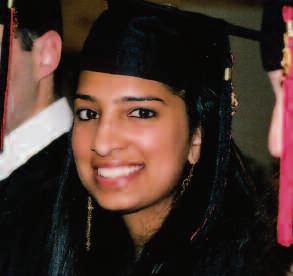

Codey, a champion for health care and mental health issues, and an advocate for education and the rights of women and minorities, began his career in state government as an assemblyman in 1973 at the age of 26. In 1981 he won election to the State Senate, and in November 2003 he was elected to the Office of Senate President.
When Governor James McGreevey resigned last year, Codey, as Senate President, assumed the powers and responsibilities of the Office of Governor In this capacity, he has worked diligently to restore integrity, stability and a sense of purpose to the governance of New Jersey.
He has made ethics in government a primary focus of his administration’s policy agenda and has insisted that his fellow legislators heed the demand of our citizens for accountability and credibility in the institutions and people entrusted with governing our state.

A traditional benediction is a blessing, a prayer. While Newark Academy has no religious affiliation, we should not deny ourselves a moment of idol worship as we sit at the feet of our beloved teachers — our mentors and our friends. One of the greatest things about this school is the number and breadth of its gurus: from the intellectual sages to the artistic virtuosos to the dodge-ball masters, we’ve got them all.
If we take with us the wisdom and common sense our teachers have proffered, we will have gone a far way towards immortalizing them. My wish today is that for the next four years for our whole lives, really — we can be in a place as open and as generous as NA, a place committed to learning and to the benefits of community.
Ryan Adeleye Davidson College
Richard Ainsley University of Durham (UK)
Jonathan Allocca Fordham University
Corinne Almquist Middlebury College
Faryn Altschuler Cornell University
Jenna Bagnoli
University of Southern California
Betina Bethlem University of Pennsylvania
Sam Birnbaum Carleton College
Danielle Blake University of Pennsylvania
Michael Calcara
Wake Forest University
Jason Cali University of Pennsylvania
Erin Calma
Carnegie Mellon University
Christina Capatides Georgetown University
Jason Chan
Massachusetts Institute of Technology
Julien Cobert Duke University
Catherine Coggeshall
Wake Forest University
Arielle Confino
Washington University in St. Louis
Annie Connors
Boston University
Juliane Corman Barnard College
Julia Cross New York University
Ashley Cyburt
University of Richmond
Brendt de St. Paer
University of the South
Daniel Deraney State University of New York-Albany
Komal Desai
George Washington University
Sarah Dobro
Skidmore College
Pallavi Doddakashi University of Maryland-College Park
Jacquelyn Dorsky
Brown University
Bridget Duffy Philadelphia University
Avi Dunn
Johns Hopkins University
Serena Eber Wilkes University
Jaclyn Emanuel University of Miami
Alice England Sheffield University (UK)
Yulian Fedulov
Carnegie Mellon University
Brett Finkelstein
Brown University
Johanna Flyer University of Rochester
Daniel Forman
George Washington University
Mark Fritze
Gettysburg College
Gregory Fullenkamp Union College
Gabriel Gaviola
Georgetown University
Kimberly Goldfarb Lehigh University
Robert Gordon
Harvey Mudd College
Jake Gorelov
Williams College
Jamal Gorrick
Harvard University
Rebecca Groveman
Mount Holyoke College
Aviad Haimi-Cohen
Brown University
Samy Hamdouche
Stanford University
Lawrence Jewkes
Aston University (UK)
Michael Khidekel
School of Visual Arts
Sarah Kirk Middlebury College
Priya Kothari
Carnegie Mellon University
Daniel Kott
Washington University in St. Louis
Brandon Lawrence
University of Virginia
Max Levy
Virginia Technological University
Emily LiMandri
Johns Hopkins University
Emily Litwin Carleton College
Jason Luks
New York University
Melissa Mandelbaum
University of Maryland-College Park
Molly McGaughan
Hamilton College
Christine McKeon Barnard College
Joli McTerrell
Temple University
Arunima Mekala
Syracuse University
Kristen Mulgrew
Hampshire College
Bobby Oboodi
Cornell University
Eva Olesky
Cornell University
Timothy Orr
Yale University
John Ostrow Bucknell University
Sean Payne
Stevens Institute of Technology
Jacqueline Peyser
Cornell University
Elizabeth Pfeffer
Colby College
Michael Pickoff
Sarah Lawrence University
Naveen Reddy
Boston University
Matthew Reichel
Brown University
Julia Reisen
Oberlin College
Christopher Resler
Amherst College
William Richardson
University of Richmond
Tracy Robinton
Cornell University
Odette Rodrigues
Harvard University
Jordan Rose
Dartmouth College
Nicholas Schifano
Villanova University
Ariel Schvarcz
Emory University
Amy Sherman
Lehigh University
Justin Silver Tufts University
Scott Simontacchi
Vanderbilt University
Jenna Slutsky Barnard College
Jacquelyn Snyder Skidmore College
Sarah Stewart University of Pennsylvania
Adam Subhas Haverford College
Nina Suda
Columbia University
Sarah Taylor Drew University
Timothy Ullmann
Northwestern University
Daniel Urban
Columbia University
Douglas Vollmayer
Pennsylvania State University
Melina Ward Middlebury College
Samuel Weinreich
Williams College
Stephen Wentz
Wake Forest University
Christine Werner
Lehigh University
Adam Yeung
Lehigh University






On March 3, 2005, the play A Funny Thing Happened on the Way to the Forum returned to the NA stage after 32 years. The first production was directed by former faculty member Hampton Abney and featured Nancy Baird Harwood ’75 in a leading role. Nancy is currently a member of NA’s board of trustees.
The spring 2005 production was directed by Scott Jacoby and featured several faculty and staff members, along with a very talented cast led by Michael Pickoff ’05, Corinne Almquist ’05, Ted Gibson ’06 and Scott Simontacchi ’05. Despite challenges from Mother Nature, the show must and did go on... and it was spectacular!
A Funny Thing Happened on the Way to the Forum was originally a book written by Burt Shevelove and Larry Gelbert. The real funny thing is that Burt Shevelove was an NA graduate, Class of 1933.
Former cast members, from the 1973 production, were invited to this year’s performance. Suzanne Citron Pitts ’73, who played the role of Gymnasia, fondly recalled:
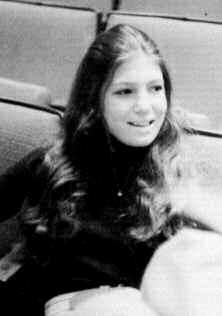




My career on stage began when I was one of the Kent Place girls that came over to try out for the Variety Show of 1969. This was back in the day when Newark Academy was all boys and had to import the (female) talent. Although my part as a “chorus girl” was not spectacular, a truly spectacular thing did occur. I fell in love with the stage, Newark Academy, and mostly the stage manager, Doug Pitts. I transferred to NA in 1971 when it went co-ed and have such great memories of Li’l Abner, Music Man, Forum, and all the fun in everything Hampton Abney produced and directed



Tony Argibay ’09 presents athletic equipment to the school principal as a show of gratitude for the tour and cultural exchange
For many years, Newark Academy students have traveled on school sponsored spring break trips. Of the nine trips conducted this past year, Señor Gomez’s trip to Costa Rica was one of two international trips, and the only trip that was open to middle school students.
Since Señor Luis Gomez joined the NA community in September 1992, he has organized and led a total of 11 trips to several different Hispanic-American countries.




This year was the third such venture to Costa Rica and involved the largest group in Señor’s history – more than 40 students from grades six through nine.
The group traveled to four different towns, each in a different ecological area. The first day was spent at the capital city of San Jose, followed by two days at La Fortuna, in the valley of volcanic mountains, then on to the Pacific beach resort of La Fiesta in Puntarenas, and finally to the mountain town of Monteverde, on the edge of the Cloud Forest.
One of the highlights was the tour of a typical Costa Rican high school, La Fortuna Secondary School. Our group of students was divided into smaller groups and given tours of the academic school led by their Costa Rican contemporaries, followed by a trip down the road to check out the school farm.
While the merit of the athletic teams’ spring trips is evident – they serve as valuable pre-season training opportunities – international trips give students the opportunity to immerse themselves in a different culture and experience the language in a way that cannot be taught in a classroom. And by traveling within several different ecological environments, as Señor Gomez’s groups do, the students not only experience different ecosystems but learn about the socio-economic diversity within the country, as well.
During the tour of La Fortuna Secondary School, NA students were given the chance to interact with the Costa Rican students on a personal level, giving them a raw view of life outside of the United States. At first glance, life in Costa Rica may seem unfortunate, with the imposing, steel security fencearound the school ground and the notion of secondary school itself being optional, but after getting to know their tour guides, Newark Academy students learned that the Costa Rican students do not consider themselves under-privileged. Charlotte Rosen ’08 summed it up well, “Though they were poor in supplies, their way of life was pure and rich.”
L Leee e A Abbbbeey y , humanities department chair, was this year’s summer sabbatical recipient. He plans to explore the origins of the Industrial Revolution in his travels to Great Britain.
S Stteepphhaanniie e A Accqquuaaddrro o , upper school English and film teacher, traveled to Paris to explore the landscape of French film classics.
D Daan n E Errllaannddssoon n , AP/IB environmental studies teacher, has earned a grant from Earthwatch to study biodiversity in Africa.
L Lyyddiia a M Maasstteerrssoon n and C Caarrool l S Sppoooonneer r recently traveled to Colorado for an intensive workshop on counseling and peer leadership strategies.
F Frreed d M MccGGaauugghhaan n , formerly the director of admission, has been appointed director of institutional advancement and K Kaatthhlleeeen n C Crroonnhheeiim m has been named associate director of institutional advancement. The admission office will now be directed by K Kaatthhlleeeen n
S Siiggrriisst t , a three-year veteran of the Newark Academy community.
Science teacher S Saannddy y P Paallmmeer r and her husband welcomed their first child into the world on April 25 – a beautiful baby girl, Willow Maxine.
B Bllaacckkiie e P Paarrlliin n and his wife, Joan, traveled to Morocco in June as part of a travel grant awarded to Blackie two years ago for completing his 45th year of teaching at the Academy.
D Daavviid d P Paassqquuaalle e , English teacher and head coach of Newark Academy’s basketball and baseball teams, has accepted a position as athletic director at Gill St. Bernards School, beginning in September 2005.

At the end of this past academic year, M Maarry y H Heelleen n E Emmmmeerriicch h closed the payroll book for the last time. After 29 years in the business office at Newark Academy, Mary Helen looks forward to enjoying more time with her growing family. She will be missed by the NA community Those sentiments are reflected in the recollections of two of her longtime colleagues:
From Sam Goldfischer, Director of Business and Finance:
“Four heads of school... four business managers... hundredsof employees... thousands of students. Mary Helen Emmerich has served them all – with a positive attitude, a kind word and a smile. Newark Academy has been as much a part of Mary Helen’s life, as much a part of her sleepless nights and as much a par t of her pride, as her husband, three daughters and 10 grandchildren have been.
When I arrived at the Academy in December 1991, Mary Helen lent an experienced shoulder. Since then, she has lent me her ear in crisis and her wisdom when I’ve been faced with a dilemma. On good days and bad, we’ve
worked side by side and throughout it all, she has freely extended her friendship and her loyalty. It’s amazing to think that her 29-year career at NA all began with a phone call to a “Temp” agency.”
From Sandy Marano, Business Office Assistant:
“When some people are having a difficult time falling asleep at night, they count sheep. Since coming to Newark Academy, I count Mary Helen’s grandchildren, recalling their names and the families they belong to!
Mary Helen has been such a strong, wonderful friend during my nine years in the business office. At difficult times, she always put things into perspective with her often repeated phrase: ‘In 10 years is this going to matter to you?’ I will truly miss her daily friendship and advice and wish her all the beauty and happiness a retirement with the one you love has to offer.”
We wish you good health and a joyous time in your retirement!
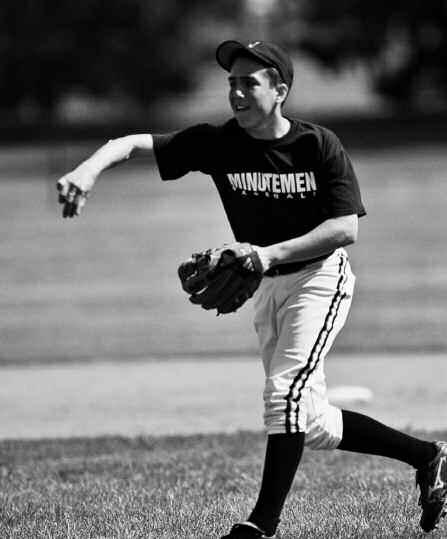
The 2005 spring varsity boys and girls athletic teams produced two team records and two winning playoff trophies.
The boys tennis team won the State Non-Public B trophy for the 27th consecutive year and climaxed their record run with a Tournament of Champions victory, their third straight overall tennis championship. NA has won this trophy eleven times since it was inaugurated in 1992. In achieving these milestones, the boys completed a sterling 29-0 record and presentlyboast a 68match unbeaten streak.
The boys baseball team continued its winning ways with a 19-11 record this year, which included a 10-2 victory over
Princeton Day School for the State Prep B title and an appearance in the State Non-Public North B championship game against Paterson Catholic.
Two of NA’s girls varsity teams set records for victories this spring. The lacrosse team had an all-time best record of 10-6 and played very competitive games against Top Twenty opponents Ridge, Oak Knoll, Kent Place and The softball team established a new singleseason mark for wins with a 16-9 record, including a victory in the first round of the North Non-Public B softball playoffs.

Overall, our spring athletic teams achieved a very successful cumulative won loss record of 91-60.

Fascinated by an interview with the playwright and actors in “Doubt,” I went to see the play, with no thought that I would be prompted to a number of recollections of my student and early teaching years.
The play, which will no longer be on Broadway when this column appears, centers on the conflict between Sister Aloysius, the head of a Catholic grammar school, and Father Flynn who is suspected by Sister Aloysius of having an improper relationship with a young altar boy. I have nothing to say here about the central issue or the plot; my focus is on Sister Aloysius.
Sister Aloysius sees her young charges as willful, the fruit of Original Sin, despicably in need of suspicious oversight and use of the switch. When a young teacher reports that a boy has had a severe nosebleed, Sister Aloysius suspects that the bleeding was self-inflicted for some devious


the masters had a sense of humor, so if they hit a student between the eyes with an eraser, they could graciously accept appreciative applause from the class. But there were mean ones. And at NA, too.
When I started teaching, I had very clear intellectual goals for my classes. When a friend asked me my goals in my first week of teaching United States history, I said I wanted to make clear the philosophical differences between the world views of Thomas Jefferson and Alexander Hamilton. I still think that is an excellent intellectual beginning for United States history.
I had given no thought, however, to what I wanted my personal relationship to the students to be. Early on I threw a few pieces of chalk and erasers, because that was my model. And I remember that my first, very first, words to my senior class were, “Listen carefully, and I’ll tell you how to pass the course.” I knew I had scared a lot of them and that seemed perfect.
communiqués of displeasure, rolling eyes, a disapproving gesture. So, without missing a beat of my learned lecture on Jefferson’s considerable trust in the goodness of man’s nature, I kicked “T” very fiercely in the calf. I was pleased that for the rest of the class “T’s” torment of the classmate ceased. After class, however, “T” confronted me. He towered over me, and his chest kept pushing me back, and he said with a threatening tone, “Don’t ever kick me again.” I confess here for the first time that “T” scared me. I gulped and managed to say with a tone of menace, “And don’t you ever again put your feet up on the seat of another student.” My heart was racing; I was scared; I should have gotten an Academy Award for faking fierceness.
At home I sat late into the evening, smoking (yes, another confession) and reflecting on the episode. I started by thinking, “I don’t kick people; that’s not me. I don’t even throw chalk at people. Why am I taking this posture in my classroom?” When I went back to school the next day, I was well on the way to defining the style of teacher which I wanted to be. Thank you, “T”– you helped me. Finally, in my first year, a group of seniors confided in me that their friend “W” was into heroin and they asked for my help. I knew about heroin only because I had read the Autobiography of Malcolm X which described Malcolm’s early years in Harlem. In my helpless and naïve way I tried to help “W” and remained a friend until he ultimately took his own life some years later
purpose. She counsels the young teacher to cultivate sternness and is proud that the students are in terror of her. She is magisterial, humorless, menacing, and a believer in corporal punishment. Affection, love, and compassion are alien to her manner. In her narrow way she wants what she thinks is best for her students, but she shows no hint of fondness for any of them.
I had a few such troglodytes as teachers and as teachercolleagues at the outset of my professional career. Most of my teachers in my boys’ school threw objects in class –erasers, chalk – and Mr. Cornet, in times of extreme provocation, would throw the Bible. However, most of
My teaching philosophy was shaped by three events early in my career. Once, when I had lunch with the saintly Otto Huddle, I asked him to give me his best advice derived from a long and distinguished teaching career. He thought a long time and said, “Just when you feel you’d like to kill a kid, sit down and talk; you’ll never feel the same after the talk.”
Then, there was my encounter in the first week with _______. I’ll call him “T” for “tough.” In one class, “T” kept putting his feet up on the seat of the student in front of him. Frequently, he deliberately kicked the rear of the student. “T” was totally unresponsive to my subtle
Again, I remember with great immediacy my late evening pondering and the realization that sometimes the great philosophical conflicts of history don’t mean a damn, and what is essential is that a teacher embrace a student with affection. In the play Doubt there is a masterful portrayal of a young nun, Sister James, who has the instinct for this cardinal principle of teaching which Sister Aloysius tries to bully out of her.
All fine teachers sometimes need a bit of the magisterial power of Sister Aloysius but must never surrender the instinct which Sister James had – to regard the student with affection.
NA

A CREATIVE SOLUTION
by Alexandra MahoneyFrom trading on the floor of the stock exchange to observing a laparoscopic cholecystectomy, from scuba diving four miles off the Jersey coast to accompanying a field representative from the Screen Actors Guild on the set of “The Sopranos” – senior projects at Newark Academy present an extraordinary opportunity to experience life and pursue dreams beyond the academic realm.
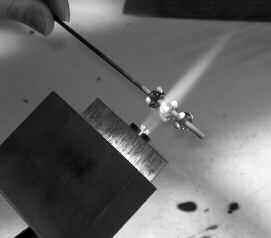




“The senior project was born in the early ’70s as both a solution and an opportunity,” explains John Limmer, one of two faculty founders of the senior project tradition at Newark Academy. The “solution” part addressed the problem of teaching seniors in the spring after they’d gotten into college: it just wasn’t working.
The “opportunity” part spoke to an educational philosophy, more prominent during the early 70’s, that embraces the importance of learning outside of the classroom. Getting students out from behind their desks and into the world was a fundamental part of the philosophy behind the value of the senior project, and it remains so today.
“It was in the air,” says Joe Borlo, the other faculty founder, referring to the educational climate of the ’70s in which both students and institutions were willing to take risks in hopes of finding innovative and exciting ways to educate young people. The idea of a spring project initiated autonomously by the senior and conducted offcampus was drifting about the independent school circuit at the time. Apparently Newark Academy sometimes likes to boast that it was the first independent school to employ a senior project program, but this assertion cannot be proven.
Still, the idea was controversial: many teachers thought such a nebulous plan a waste of time; students ought to be in class.
The very first incarnation of the senior project consisted of minicourses which offered non-traditional subject matter, like writing a science fiction novel or building a bird-house. This idea failed, though, because the essential problem of keeping a senior happy and engaged during the final months remained.
Some Faculty Favorites
• Shadowing a surgeon
• Biking in China
• Interning with a massage therapist
• Serving as a volunteer fireman
• Learning equine massage
• Canoeing the Delaware
• Investigating the 1906 San Francisco earthquake
• Working on the floor of the New York Stock Exchange
• Assisting a wild animal veterinarian
• Researching dolphins in Florida
• Interning for the Daily Record
• Living in a convent
• Producing a CD in a recording studio (a group project)
• Working for the Georgia Sea Turtle Conservation
“The senior project offers the opportunity to learn about a new and exciting enterprise or activity, in depth, for up to four weeks. In taking up such an opportunity with both enthusiasm and a sense of responsibility, seniors will have a chance to test themselves against the world in a significant way,” states the 2005 Senior Project pamphlet. Sometimes the new and exciting enterprise unexpectedly becomes a first stepping stone on a path of personal or professional significance as the graduate moves from Newark Academy’s community into the larger world.
From Blackie Parlin on his son’s senior project
“My son, Andrew Parlin ’79, wanted to experience a utopian commune. He made contact and spent a week or so on each of two, The Farm in Tennessee and a Christian commune founded in Georgia in the 1940s by a bi-racial group. I knew that on The Farm there would be “hippie types” and wondered about drug use.
I called the local sheriff, explained my son’s assignment and purpose and then said, ‘I trust my son’s maturity and ability to take care of himself, but I want to know if there is danger on The Farm.’ He said, ‘Well, Suh, I hate to tell you but there is some marijuana in every community these days, but the folks on The Farm are good-hearted and your boy will be safe.’
Andy found both communal societies to be fascinating in their organization, leadership and policies, but he discovered that communal living was not for him.”

“We needed to do something for them,” explains Joe, hitting on another fundamental element of the senior project idea. In its conception, the project respects rather than limits the senior poised uniquely on the cusp of independence and adulthood. His duties to his academic education are complete, and he anticipates the challenges and joys of college life a few months away. A 1979 document explaining the senior project guidelines states:
“Each high school wrestles with the problem of providing a productive and meaningful experience in the spring for seniors who have been accepted to college. Your thoughts look ahead to the future and the routine of classes seems unimportant. Newark Academy believes that the senior project is a creative solution.”
The document acknowledges the uniqueness of the spring senior’s mentality and describes an opportunity tailored especially for this potentially fertile mindset.
So Headmaster Bradford and Assistant Headmaster Manning agreed to the experiment. The senior project was initially voluntary; it became a graduation requirement in 1975. And thus a thirty-year tradition was born.
The senior project survives into the 21st century and, thankfully, remains true to its roots both in philosophy and structure despite our more conservative times. Certainly the parameters of what is permissible have evolved a bit. Students are no longer allowed to hitchhike to Nova Scotia. The project’s objectives, however, remain the same: the

experience offers students an opportunity to do something they would not ordinarily be able to do and/or it offers students an opportunity to explore a potential professional interest. John Limmer affirms that we value both approaches, the creative and the practical.
In fact, the nature of the project is more process-oriented than product-focused. The challenge for seniors of initiating an idea, finding a reliable sponsor, and completing the project’s requirement remains at the heart of its merit. This process generally brings a multitude of obstacles and a frequent need for revision. Even projects which might not necessarily make an engaging magazine article fulfill the objective of allowing seniors to “test themselves against the world in a significant way,” as the 2005 Senior Project pamphlet states, through the process of generating and executing their project.
The project contains some general guidelines. A student may not work for a family member. A project “must have the promise of personal growth and learning,” as stated again by the current pamphlet. Cleaning out an uncle’s attic (a VERY early proposal) lacks a certain educational component. Students must have adult supervision in some form when devising an outdoor experience. Inexperienced students who, camping by themselves, getting caught in rain, contracting dysentery and returning two days later, certainly learned something but didn’t follow through with their plan. Today students can travel with an organization, like Outward Bound or the National Outdoor Leadership School. Mr Parlin laments these restrictions on outdoor experiences, as he fondly remembers students in the ’70s independently biking or canoeing along the eastern
While the daytime hours at WDHA weren’t all that exciting – copying and gopher tasks and such, it was Friday night Metal Night with Cheryl Richards from 10-12pm and the Saturday night All Request Show with Manny Glynn in the same time slot that really made the project interesting. Suzanne was able to work in the control room with the hosts, answering phones for requests and occasionally getting some air time herself. The leftover concert tickets and free T-shir ts from the DHA van onlocation give-aways weren’t bad either. This experience created networking opportunities, Suzanne attests, and also provided some tricks of the trade that she took into her job at college where she worked at the campus radio station. “At DHA I learned things like different ways to talk so I wasn’t ‘umm’-ing and ‘ah’-ing all the time,” Suzanne recalls, after putting her toddler down for a nap. “I was able to go on-air immediately in college.” Also during college Suzanne worked as a summer intern at Mercury Records in the publicity department. After graduation and before motherhood, Suzanne earned a living booking concerts for the Agency of Performing Arts, now called Creative Artists Agency, the second largest booking company in the nation. For Suzanne, the senior project provided the unexpected bridge between an adolescent obsession with heavy metal music and the career in the entertainment industry.
“I racked my brain for weeks trying to figure out something to explore for my senior project. I wanted to do something new that I probably would never have the opportunity to try at any other point in my life. I came across glassblowing, which at first sounded exciting, but later learned I would not really have a hands-on experience. I then found Lisa Joy Sachs’ website; she is a jeweler in Jersey City who makes her own lampworked glass beads. After I set up an interview, I realized that this was a perfect senior project because I would be making glass beads and even be able to keep some of them for myself.
I learned how to heat up the glass, make beads, prevent cracks, and string together necklaces, bracelets, and earrings. After taking two classes and working endless hours in the studio, Lisa Joy approved of most of the beads I would make. This meant that my beads were used in her jewelry and being sold in necklaces and bracelets at art shows up and down the East Coast. This was a wonderful and rewarding experience. I not only learned how to make glass beads but gained insight into the art world and the business world. In addition, I am now a glass bead maker and hope to apprentice again next year at college for a different jeweler.”

’04
seaboard. Over thirty years, the school has learned, however, that having a mentor or sponsor gives students a much greater chance for a rewarding project. The 2005 pamphlet states in bold and italics that “The most important guideline is that the project involve learning from a mentor/sponsor who is experienced in the student’s area of interest.”
Today, projects need to be approved by the upper school administrative staff. “The project should be a new experience or an extension of a student’s experience, not a repetition… A project acceptable for one student, or one approved in a prior year, may be the right project for another student.” These guidelines strive to push students to experiment with new experiences and to take risks in unfamiliar environments.
Of course with risk comes the potential for disaster.
More often than disaster, though, a project just doesn’t deliver on its promises. Perhaps a sponsor doesn’t follow through. Perhaps a student is used only to complete boring office filing or other mindless tasks. Faculty member Cathy Pursell warns seniors, “Only students who have well thought-out projects and who have planned well in advance get a lot out of their projects. Also the sponsor or group the student is working with needs to fully understand the principles and philosophy behind the senior project.”
Students learn that they cannot always control whether a circumstance is fulfilling or not. Many learn hard lessons about the adult world.
’05
“The senior project experience was an extraordinary look into non-academic life. The skills I learned are wonderful tools that I will have forever and the taste of adult life helps me better plan out my future. I thank those at Newark Academy for entrusting the seniors with such freedoms to pursue our interests in such an adult manner. This was a unique ending to a beautiful four years of academics.”
Dennis Vasquez ’92, Newark Academy’s college counselor, expresses remorse about his own lack of creativity when approaching the senior project requirement in 1992. He worked at his uncle’s dental clinic in Los Angeles, helping him perform cleanings and exams and such. Dennis writes,
“In my days, it seemed as if students took the value of senior projects for granted – it was just another hurdle and space-filler before graduation. Now, I am pretty envious of the creative ideas many seniors come up with to make senior projects actually fun and productive.”
Sometimes the disappointments are instructional; sometimes they are just disappointments. The senior project is not a life-changing event for everyone.
Some surprises look like disappointments. Pegeen Galvin, who currently monitors the senior projects, remembers a student who wanted to be an architect. He developed a project in which he worked in a firm that constructs architectural models. The student soon discovered that his hands were simply too big to be able to work with such small objects.
There is one common type of surprise generated by the senior project: “You start with one thing,” says Joe Borlo, “and you come back with another!” Joe remembers a student who went to live in and study a Zen Buddhist monastery in New York State. Unbeknownst to the young
’74

Dave Hosseini ’74
Senior Project: Exploring a Variety of Social Welfare Sites
“My senior project could not have been more prescient in terms of how my later life would unfold, and also seemed to be a perfect bookend to a time in my life that was not always happy.
Because of the generosity shown to me by Newark Academy faculty members and especially by a few select non-profit agencies during the personally trying times of my adolescence, I thought that perhaps I would like to enter the service professions. With the help of many people, I devised a schedule [for my senior project] which brought me to such places as a drug rehab program, a school for the deaf, a center for delinquents, and a Bowery mission. All this was capped by a stay at a spiritual commune in Canada.
The impressions stuck; I have spent the last two and a half decades working in social services, including a 10-year stint as executive director of a mental health agency. Currently, I am public policy advocate for an association of mental health non-profit agencies. I remain eternally grateful to Newark Academy on many different levels.”
Senior Project: Living with a Mennonite Family in Pennsylvania
“For me, the senior project proved to be far more than just an NA tradition. It ended up being a life-changing experience and one I will always treasure.
Twelve years ago I lived with an AmishMennonite family, the Nissleys, in Paradise, Pennsylvania to learn about their community and way of life. I learned far more than I ever anticipated I would, and before long I realized that my senior project would fulfill more than a graduation requirement.
After graduating from NA, I returned to Paradise to live with the Nissleys for the summer before heading to Virginia to attend Sweet Briar College. I knew that one day, if possible, I wanted to return and live in Lancaster County. After four years at Sweet Briar, one year in Boston, and six years in Vermont, my prayers were answered and a dream was fulfilled.
On June 21, 2004, I returned to Paradise to live. My neighbors are the Nissleys.
On July 30, 2005 I married Jimmy Zook, a man to whom I was introduced by a Nissley daughter. On the bottom of our wedding invitation appeared the verse: ‘The Lord hath done great things for us; whereof we are glad’ (Psalms 126:3). Having had the opportunity and privilege to attend Newark Academy and benefit from one of its traditions is most certainly one of those ‘great things.’ My senior project remains one of my fondest memories and experiences.” a m e n n

man, the monastery ran a chocolate factory, and while he entered expecting to learn about the somber practices of Buddhist monks, he, instead, became skilled in the art of chocolate-making!
Finally, we teachers are surprised. That is, of course, why we teach. Joe remembers how the project approval committee wanted to reject a project proposed by a student who planned to work in the fashion industry. The committee thought the subject matter was “too super ficial.” The project was approved nonetheless and the student had a superior experience learning the ins and outs of the fashion industry.
The range of surprises the project precipitates can hardly be enumerated here. Feel free to write and tell us what surprises your senior project has brought you. Sitting in on advisor groups in the last weeks of school and listening to seniors tell about hours of monotonous painting at Habitat for Humanity or showing a close-up, graphic video of a cat being neutered is very inspirational indeed. In fact, several summers ago, I searched out a midnight bakery apprenticeship in artisan bread-making so I could taste a little bit of the excitement of stepping out of my routine and my comfortable places to take a risk and discover something unexpected. I love the taste of a well-shaped baguette at four in the morning.
Let us not lose the meaning of the lessons the senior project brings us. As we shape our adult lives around responsibilities and the familiar, let us step outside those routines and those tired places, take a risk, and see what surprises we find.

When Justin submitted his application for an internship position for the NJ Jackals baseball team, the stadium wasn’t even built yet. “I loved baseball,” says Justin, “and becoming a sports manager was a major aspiration at the time.” Justin’s timing for getting his foot into the door of the world of baseball management could not have been better. Since the stadium was under construction, Justin filled in wherever there was a need: for a receptionist, a development person, a salesman. He put in office time answering phones, making cold calls to potential sponsors, and selling tickets.
Eventually, though, the assistant manager, Hank Manning, needed a clubhouse manager. So Justin took on responsibility for overall baseball operations, which consisted of, as he explained, “a lotta laundry, bringing equipment on and off the field, shining shoes, making sure uniforms were in good order, and ensuring a steady flow of food to hungry ball players.” The reward came in his close interaction with all of the players, with the excitement of hanging out in the dug out day in and day out.
The unexpected opportunity demanded far more hours than the project required. Justin chose to quit the NewarkAcademy baseball team and work for the Jackals beyond the requirements of the senior project. He was given a paid job through the summer and for the following summer as well. During college he landed a paid internship working for the Baltimore Orioles, helping with the public relations end of the baseball machine. And today, though Justin primarily earns a living working as in a different field, he carves out time to work for the Orioles, operating the scoreboard during home games. As a current member of the production crew, Justin makes use of the technical skills he learned in college as a computer science major. He enjoys seeing the game from so many vantage points. Justin s not hanging out with the players in the dug-out these days, and the excitement of his role is a little less immediate and a little more abstract. “But the scoreboard drives the stats of the game,” Justin explains, “and accurate stats are a crucial part of the game.”
“The senior project allows students to ‘try on a career’ when the stakes aren’t high,” says Dean of Students Pegeen Galvin. “There is a freedom in the senior project: it doesn’t go on your transcript and it doesn’t have to appear on a resume.”
a train ride
“Given the parameter: Your senior project must involve something you cannot do in a classroom, five of us (Steve Zargham, Matt Rankin, Jerry Guss, John Rees and I) left Newark Penn Station to ‘see the USA the Amtrak way.’ We took a three-week train trip around the country spending time in Washington, D.C., Atlanta, New Orleans, Los Angeles, San Francisco, Denver and Chicago--not to mention a lot of time on the train! We even had an unscheduled 16-hour stop in Sanderson, Texas, just north of the Mexican border, on our New Orleans to Los Angeles leg as a train derailment ahead of us had closed the track. This gave us a chance to practice some foreign relations with a group traveling on the train from Switzerland, as well as brush up on the Spanish lessons we had with Mr. Abney while watching a New York Yankees game broadcast from Mexico in Spanish. All in all, we had a great time!”

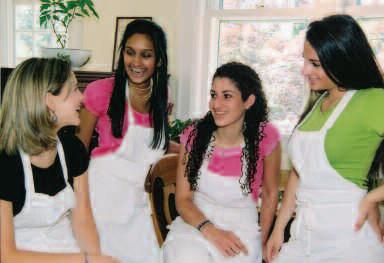
For Jackie Dorsky, Pallavi Doddakashi, Amy Sherman and Dani
Blake, the quest to find the “right” senior project evolved in a most unexpected way. At an NA bake sale fundraiser in support of Ms. Luxemburg’s advanced dance class, the girls purchased some chocolate raspberry brownies that were fantastic. The rich, mouthwatering mounds of chocolate, teeming with the luscious, savory berries were prepared by pastry chef Dolly Rosen, mother of ninth grade student, Charlotte. The senior girls, convinced that they would love to learn how to cook like that, asked Dolly to sponsor their senior project.
Now for some, the thought of baking brownies and scones might seem frivolous. Not so, with Dolly Rosen in charge. A graduate of the French Culinary Institute in New York, Dolly enthusiastically planned a serious curriculum for her “students” that not only included preparing sumptuous feasts (omelettes, spiced waffles, cakes, gelato, popovers and cheesecake) but also included taking a number of field trips (even to see a movie) to expand and enhance the overall experience.
“We visited Raymond’s Restaurant in Montclair, said Jackie, “And when we took a tour of the kitchen, I was shocked to see how small a space the chefs had to work in.” Dolly’s kitchen, on the other hand, is of mammoth proportions for a residential one, but with all the charm of a French bistro. Two large bookcases overflowed with ever y type of cookbook imaginable, confirming that an avid cook lived there. Clearly, Dolly’s home was the perfect venue for the four girls to learn the art of cooking and Dolly was the quintessential teacher.
Reflecting on her senior project, Pallavi said, “The experience was unbelievable! From trips to the city to visit a cooking school, the chocolate factor y and a cake store, to the imaginative tea parties and pizza day s I would not have traded projects with anyone.” Jackie, Amy and Dani agreed that their last experience at NA together was not only a unique learning adventure but a chance to solidify their friendship before heading off to different colleges in the fall.



In 1974, the senior project at Newark Academy shared the same objective that it does today. It had to be a learning experience in something that you had not done before. The variety of project ideas for our class ranged from the practical to the extraordinary. One student elected to take a course in typing, many others worked in family businesses and several more, the adventurous types, mapped out challenging hikes and camping trips. Jeff Pollack and I agreed to do a project together but the idea was not entirely our own. In fact, we would become the unskilled labor in a brilliantly crafted plan conceived by one of Newark Academy’s most well-traveled, worldly and gifted thinkers, Blackie Parlin. Our senior project would be a bike trip. But Mr. Parlin’s idea was not without a motive!


“The Sting”
Mr. Parlin had just bought a new bike, a Schwinn Paramount, to make a transcontinental trip that summer. Blackie’s new bike cost what some people would spend on a nice used car. Of course he needed to sell his old bike, and that’s where I came in. His bike was a three-year-old Raleigh Professional with Campagnola Neuvo Record components and 15,000 miles on it. I was the buyer; a kid new to biking, who just found out that he needed a good road bike for his senior project. It was the Newark Academy senior project equivalent of “The Sting.”
Jeff and I planned a trip that would involve two bikes, two round-trip plane tickets, two foreign countries, two international student IDs, over a dozen youth hostels, one boat ride, one hitched ride in the back of a tractor trailer (actually the bikes were in the back… with the beer… we were up front), 250 miles of cycling, 80 more in a beer-hauling 18-wheeler and, most importantly, a learning experience in something that we had not done before.

Our itinerary began at Newark Airport three hours before flight time. We arrived early, not for security reasons, but rather to allow ourselves enough time to pack our bikes in the large cardboard boxes provided by the airline. In general terms, our trip would take us to the Netherlands for two weeks and to the southern part of England for a third. We would fly into Amsterdam and home from London.
For the entire period, we stayed in youth hostels, where guests were expected to help with basic chores like cleaning bathrooms, sweeping floors, preparing meals and cleaning up. We packed light enough to carry all of our belongings in two panniers and one handlebar bag. Breakfast and dinner were served at the hostels and we bought lunch each day so that we did not need to carry any food as we traveled.
We mapped out a large clockwise circle through the Netherlands. Beginning in Amsterdam we headed west to the coast where the countryside rests dangerously low against the North Sea. From there we traveled north, up the coastline and then inland to Den Oever. There we cycled northeast across one of the world’s longest dikes, the Afsluitdijk. Over 20 miles long, it separates the North Sea from the IJsselmeer. Continuing with our circle, we traveled south into the rolling pine forests of the Sand Plains, one of the most central regions in the Netherlands and one of the few that is above sea level. We passed through delightful little towns where residents went out of their way to make us feel welcome. I recall one man who approached us while we were looking at a map on the side of the road and offered some freshly baked chicken and local directions. Both the directions and lunch were unexpected yet greatly appreciated. He was a complete stranger and a perfect host. The towns all had memorable names, some funny and some odd; Sneek, Wolvega, Meppel, Zwolle, Epe and Arnhem. Arnhem would be as far south as we would go. From there we tur ned right and headed east to the industrial city of Utrecht, continued on to The Hague and then turned south for a short leg down to the coastal city of Hoek Van Holland. There we would get off our bikes and board a ferry for Dover, England nearly six hours away. From Dover, we made our way up to London where, in a completely tourist frame of mind, we stayed for several days.


British Route by Train
We were more stationary in England, and if we traveled, it wasn’t by bike. We were losing our fascination with biking. Despite all of the “training” that we had done prior to our trip, we were tired from the last two weeks of pedaling our 60-pound plus bicycles all over the Netherlands. We even talked about “accidentally” losing them in one of Holland’s many inland canals; a freaky cycling mishap where both bikes would be lost forever in a watery crash, while both riders escaped dry and unharmed! We didn’t think anyone would believe us, but the fictional exercise kept our minds off our growing dissatisfaction with the sport.
When we found ourselves in the mood to travel again (by some means other than bicycling), we took the train from London down to Canterbury, spent the afternoon visiting all the obvious attractions and caught the last train back to London at the end of the day. Back in London we started making preparations for the trip home. We debated again about leaving our bikes behind and even though I had just purchased mine from Mr. Parlin, I was especially tempted, thinking I would be completely content if I never rode it again. Thankfully, better judgment prevailed and we brought them home. The trip was over, it was a fantastic experience but we were tired –tired of biking, tired of living out of pannier bags, tired of eating youth hostel food and quite frankly a little tired of each other. We had met the requirements of our senior project and we were ready to come home.
On
Culturally, this trip was a gem. Most unforgettable were the Dutch and English people, the ones who gave us directions and food, who shared wonderful stories about their lives, who always spoke English because we could not speak Dutch and who made us feel as welcome as family
For nearly a year after I was home I did not ride Mr. Parlin’s bike. We needed a little time apart. I am happy to report however, that over the past 30 years I have remained actively involved with cycling and I can thank Mr. Parlin for sparking that interest in the spring of 1974. I still have his bike. It is a beautiful example of cycling from a generation ago; the sport and equipment have changed a lot in 30 years. I have repainted it and maintain it carefully. It has been with me on dozens of bike trips throughout New Jersey and New England. Today the bike has nearly 30,000 miles on it and while I own two newer bicycles, I still ride Mr. Parlin’s occasionally.


Almost synonymous with the senior project is the annual ARIZONA
led by John Limmer.






John first took a group of students to the American South West in 1983. “The core of the experience,” says John, “is to get away from civilization.” Students learn about an area of their own country not by passively observing, but by doing and experiencing. John likes the dramatic difference of the landscape from suburban New Jersey: “It’s so different it’s almost like another planet.”
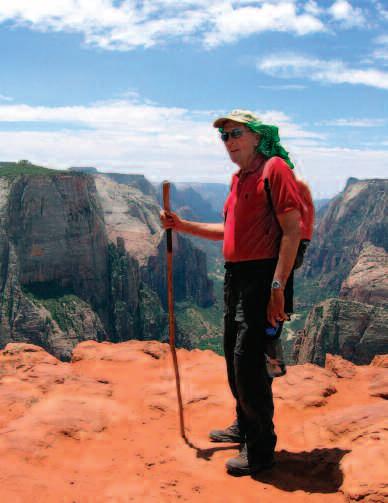
twenty-two years and GOING STRONG!
The trip consists of a four-day river jaunt, visits to the “Crown Jewels of the Southwest,” or Arches, Bryce, and Zion National Parks, and finally a hike in the Grand Canyon. “The kids think it’s all about hiking and surviving,” John muses,” but really it’s about gaining a knowledge of the land, a knowledge of geology, a knowledge of human history, and a familiarity with the Native American history of this area in particular.” John says he likes to “sneak in” the information around the fire at night when the students are all exhausted and defenseless.
John just completed his 22nd trip and has kept a written journal of each one. Currently, he is trying to compile a photographic record of each trip, and he invites people to send in group pictures, particularly from years ’91–’96.
His 25th anniversary trip is coming soon. Will these trips extend beyond the 25-year mark? Who can tell? If it’s up to him, John says, “The kids can’t wear me out! I know how to pace myself. I might wear them out, but they can’t wear me out!”
Send in your photos and reflections about how much the Arizona trip has meant to you; perhaps you’ll see them in a 25th anniversary article in Outreach. Bring it on!










Fourteen days, 26 people, 98 hours of manual labor and two houses later, my life has been changed forever.Hours after finishing my last AP exam, I boarded a plane at JFK Airport and, two days later, arrived in Colombo, Sri Lanka. When I filled out my senior project proposal form, I said my job and goal was to build houses for tsunami victims. However, soon after arriving in Colombo and driving for hours down the coastline, I realized that a different job needed to be done.
My mother and I joined a group of 24 other volunteers in Sri Lanka, all working with an international volunteer organization called Global Crossroad. The group consisted of people spanning a wide age range and hailing from countries like Zimbabwe, Ireland and the United States. Our initial drive from Colombo to Galle, the city that our project would take place in, was about five hours long. Sri Lankan roads are governed by no laws or traffic lights but instead by a lot of beeping horns that seemed to be used for no reason at all other than to disturb pedestrians and wake sleeping children. Shortly after my arrival in Sri Lanka, I learned that the “chaos” on the roads is actually tame compared to the disorder wrought by the tsunami.
When the tsunami struck on the day after Christmas, the country of Sri Lanka, along with many neighboring nations, was left paralyzed. There was no warning and the tsunami struck so quickly and so hard that nothing could be done. City walls, shops, houses, and just about everything else in sight was ruined. One colossal wave destroyed parts of Sri Lanka and much of South Asia, sweeping away dreams and bringing pain and suffering to thousands of people and families. I saw this devastation on that first drive down the country’s back. The entire coast resembled a war zone. It was rare to see buildings or homes completely intact; the roads were lined with tents and filled with rubble.
On the program’s first full day, the project leaders discussed their goal with us: we were to complete a house and dedicate it. For two weeks, we were on the work site from 8:30 a.m. until four in the afternoon. The heat was nothing like I had ever experienced; we spent the whole day in 100-degree weather, with no air-conditioning, fans, or even a breeze to relieve us.
While there were very few skilled workers in the group, by the end of the trip we all had learned the basic skills to build a house: from digging the foundation to putting on the roof. And we didn’t work alone: the neighbors, who were victims of the tsunami and had their houses destroyed and rebuilt by past groups, were there beside us. They provided us with energy by baking bread and making tea; they provided extra hands and joined in on assembly lines and with whatever else we needed. Everyday at two o’clock, we were joined by a rush of kids. They would come in their pristine white school uniforms and start digging and sifting and pitch in to do whatever else was needed.
Nothing prepared me for what I discovered on my trip to Sri Lanka. The images on television and in the newspapers do not come close to showing the damage of the tsunami. While six months have passed since the tsunami hit, a lot has been done but so much more is needed. The sides of roads remain in shambles; rubble and tents line the streets; the refugee camps provide little shelter as the heat has displaced people from their tents. The work was intense; no one on the trip had ever worked that long and that hard in his or her life. I never expected to work so hard, sweat so much, smell so bad, eat so little and yet I would do it all again.
At the end of the two weeks, we achieved our goal. On the final day, in a very emotional ceremony, we dedicated the homes to two very grateful families. And in the end, while we gave these families new homes, I’d also like to think that in a small way we also gave them the ability to restart their lives.
e b u i l d i n g l i v e s NA r e b u i l d i n g l i v e s


More than 100 golfers enjoyed a sunny day on the challenging Wild Turkey Golf Course at Crystal Springs Resort, playing to benefit Newark Academy. Prizes were awarded to the various foursomes for longest drive, lowest score, and closet to the pin among others, while the satisfied golfers enjoyed the cocktail reception. There were silent auction items including threesomes at Baltusrol, Hollywood, and other area courses, as well as raffle prizes including four iPods. Everyone enjoyed the day filled with golf, friendship, and fun, raising more than $50,000 and making this year’s Minuteman Golf Invitational our most successful golf outing to date.

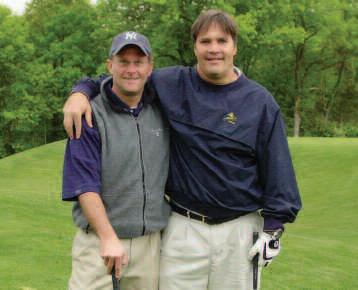
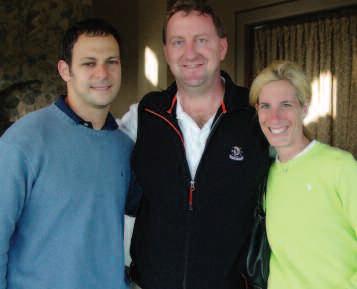




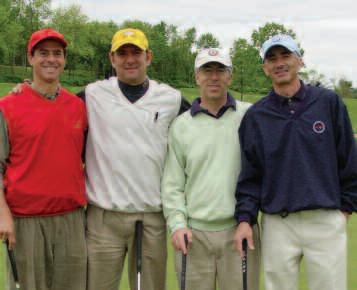

NEWARK ACADEMY
EBERSTADT ROOM
APRIL 28, 2005
1: Penney Riegelman and William Stroh ’48
2: Roger Kopstein ’48 and Micky Gilman ’47
3: Robert Cronheim ’46, Alan Moscowitz ’46 and Donald Holtzman ’46
4: Augustus Baker ’32 and Harris Cohen ’83
5: Pache Barcliffe ’96 and George Kondak ’54




